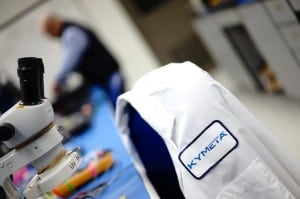Latest News
[Via Satellite 05-19-2015] Kymeta is enhancing the ecosystem for its unique metamaterials-based mTenna series ahead of the commercial release of the company’s 70-centimeter Ku-band apertures in 2016. The company has signed partnerships with Airbus Defence and Space on maritime connectivity, Intellian on maritime, Intelsat on next generation capabilities, and Honeywell and Inmarsat on aviation.
Nathan Kundtz, president and CEO of Kymeta, told Via Satellite that for 2015 the company is honing in on its core capabilities and will see greater collaboration with partners such as systems integrators, satellite service providers and satellite operators to prime the pump ahead of the mTenna’s commercial release.
“This year is all about forming these integration partnerships. We are a relatively small company and it’s so important that we focus on getting our antennas to market, but to make compelling products you have to have full terminal integration and service providers in partnership with you,” said Kundtz.
He added that much of the $20 million the antenna manufacturer raised last December from Bill Gates, Lux Capital, and other existing investors is going toward the final production of Antenna Subsystem Modules (ASMs) — i.e. the mTenna — and getting development kits in use. Integration partners will receive development kits for Ku-band this year, followed by antenna modules next year, Kundtz said. The goal of sharing these developments kits is to vet any and all bugs associated with terminal deployment advances prior to commercial launch.
One of the company’s most significant partnerships is with Sharp Corporation, which will eventually enable the mass production of mTenna products. Earlier this year Kymeta made a breakthrough realization on the feed structure for its antenna to make polarization dynamically selectable. This discovery, along with the previous knowledge that the active layer in the company’s antennas was very similar to Liquid Crystal Displays (LCDs) made the Sharp agreement even more important. Kundtz said Kymeta’s antennas have a set of resonators with a liquid crystal gap to which voltages are applied in much the same way one would apply voltages to a pixel. This created a very synergistic opportunity to work with the LCD display industry on Thin Film Transistor (TFT) manufacturing.
“Over the years we’ve been working to harmonize our development with what manufacturing is available in the LCD display industry, and so this innovation on the feed structure also allows us to move in that direction much more quickly to the point where now our first antenna modules for commercial use will be produced on LCD display manufacturing lines,” he said. “The reason that’s important is: for any of the high volume applications, that has pretty dramatic cost implications. It also means we are leveraging $250 billion of invested manufacturing infrastructure and 30 years of manufacturing experience directly from the display industry.”
Many of the antenna manufacturer’s partnerships are laying the foundation to reach into high value markets. Kundtz described both the maritime and aviation markets today as “significantly constrained,” by available hardware and current pricing. The company is expecting that the maritime market, using electronically steered panel antennas, would expand to almost a million units if measured at 30-foot yachts and above, compared the estimated 60,000 VSATs fielded today, according to Kundtz. Likewise Kymeta can look to reach regional and single-aisle business-jet-type platforms in the aviation space. But other newer markets are also of interest to Kymeta.
“The one that’s really notable are the opportunities in the automotive space,” said Kundtz. “We’ve been working with an automotive [Original Equipment Manufacturer] OEM that is very interested in finding alternatives to LTE to bring data into cars. For broadcast or multicast services there’s really nothing more effective than satellite, and there are a number of applications for that kind of connectivity, such as software over the air, mapping updates — which become very important in the world of autonomous cars — and ultimately infotainment.”
More than a year ago Kymeta partnered with UIEvolution and is also a partner of Toyota on automotive connectivity. Though a potentially challenging market for satellite, the connected car is expected have significant bandwidth needs which satellites could play a role in serving.
Another potential market is that of the large Low Earth Orbiting (LEO) broadband constellations announced recently such as OneWeb. LeoSat, currently led by former Kymeta CEO Vern Fotheringham, intends to use Kymeta antennas for a future constellation of Ka-band High Throughput Satellites (HTS). Furthermore, in his former role as CEO, Fotheringham described the company as having an “informal acquaintance” with Google for an appreciable amount of time. Google took a stake in the satellite industry through its purchase of Skybox Imaging last year for roughly $500 million, and is also an investor in SpaceX.
“It’s going to be some time before those are launched, and we will have antennas in the market for some time in advance of their need. That will really help them to be able to point toward existing products that can meet their user terminal demands in a way that is both compelling from a performance standard as well as cost,” said Kundtz.
The company does not have a timetable for when it will begin mass production with Sharp, according to Kundtz, but will determine when this approach is viable based on the market. According to Kymeta’s plans, when demand is there, the company will have what it needs to meet it. In the meantime, the focus remains on new partnerships.
“[These] agreements really underlie that strategy and we are having a lot of success with that strategy in other verticals as well. So if the beginning of the year looks busy, you should expect the year to continue to look busy,” he said.
Get the latest Via Satellite news!
Subscribe Now